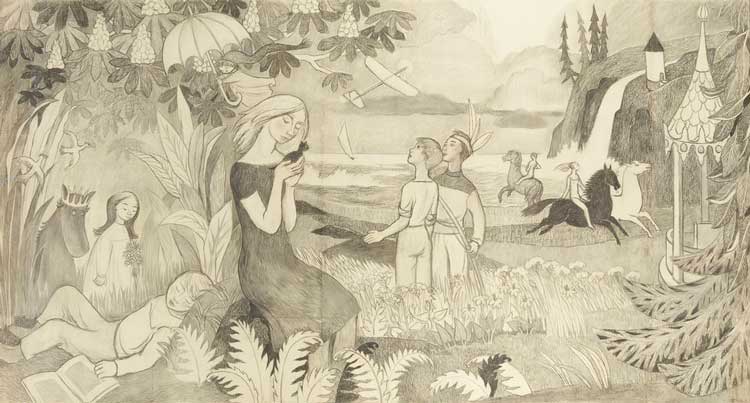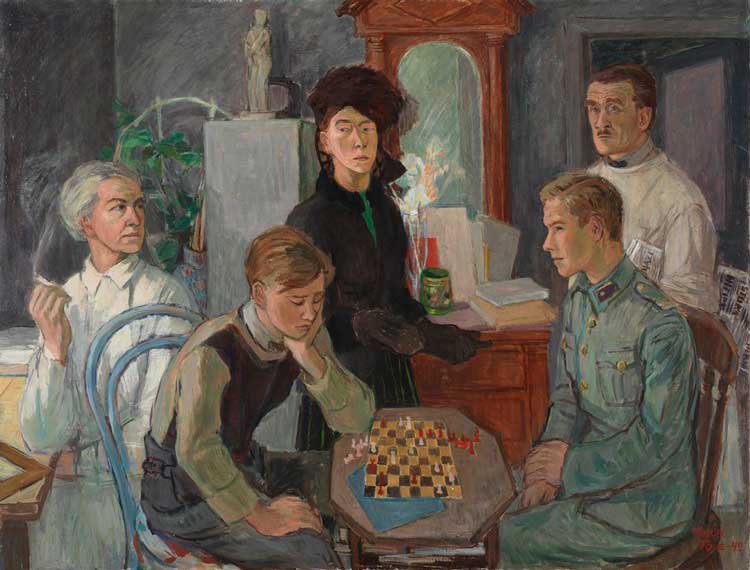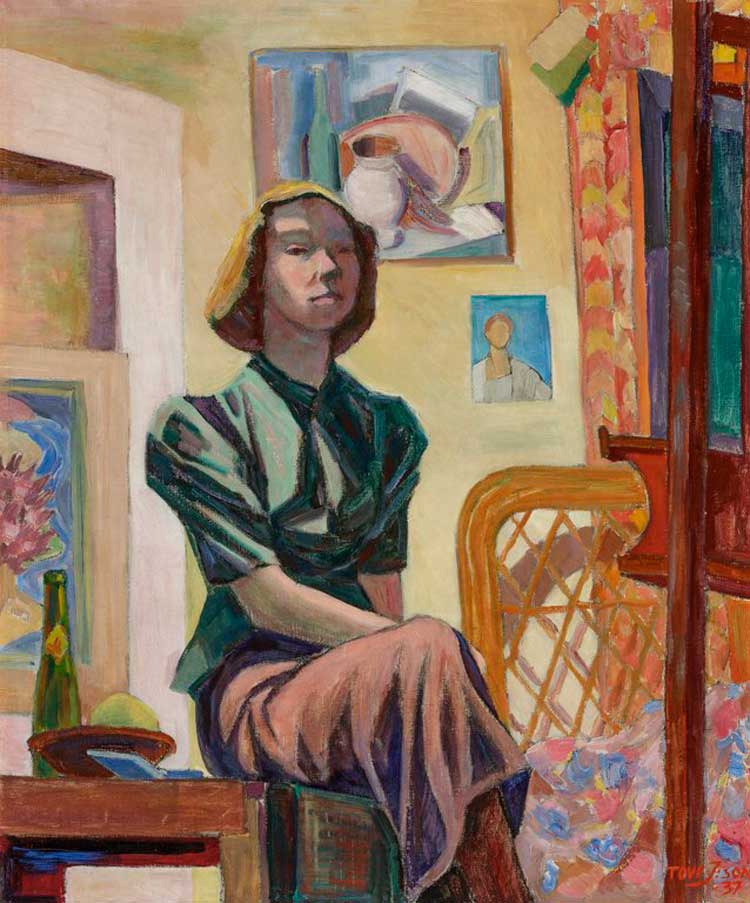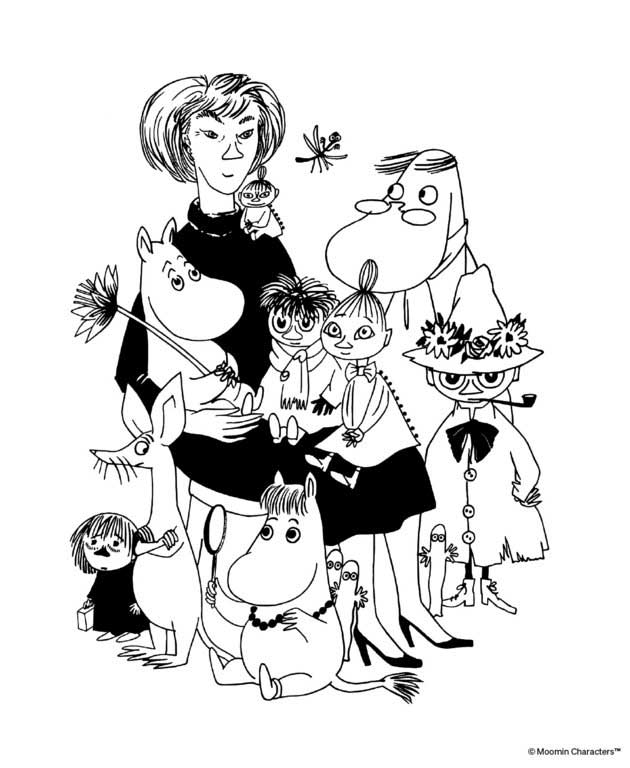.jpg)
Installation view from Tove Jansson: Paradise. HAM Helsinki Art Museum 25 October 2024 – 6 April 2025. Tove Jansson: Fantasy, 1954. Nordea Art Foundation. © Tove Jansson Estate. Photo: HAM / Maija Toivanen.
Helsinki Art Museum, Finland
25 October 2024 — 6 April 2025
by CHRISTIANA SPENS
Tove Jansson (1914–2001) is best known for creating the Moomins, a fantastical family of Finnish creatures who are now a global phenomenon, and a national treasure in Finland, with various characters adorning teas, biscuits, plates and books at every turn (I am sipping Moomin Sweet Heart tea, as I write). But what this new exhibition at Helsinki Art Museum reveals, with more than 180 works of art, is Jansson’s long commitment to public art, out of which the success of the Moomins originated 80 years ago.
.jpg)
Tove Jansson and a full-scale sketch for the Party in the Countryside fresco, 1947. Moomin Characters Collection. © Tove Jansson Estate.
In particular, Jansson’s vast murals are shown here, which were commissioned for many important buildings in her hometown of Helsinki, from the children’s ward of the Aurora hospital, which Jansson painted after winning a competition organised by the City of Helsinki in 1955, to the Domus Academica student residence and the restaurant of Helsinki city hall. In her children’s hospital piece, characters from the Moomins make an appearance, and in the other works, further fantastical characters create visions of harmony and joy.

Tove Jansson: Bird Blue, 1953. Commision for the canteen at the Kila Swedish-language elementary school (today Karjaa co-educational school). City of Raasepori. © Tove Jansson Estate. Photo: HAM / Maija Toivanen.
In the catalogue for the exhibition, Dr Johanna Ruohonen quotes the Helsinki Art Committee’s summary of the purpose of the hospital mural: “The painting on the wall of the building’s stairwell should be able to fully capture the children’s interest so that they don’t have time to think about being in a hospital. The work should also be of such a nature that a child in the hall wants to climb the stairs to see what images might be upstairs. In this way, the child would not even notice that they have moved to another floor.” Jansson clearly understood the requirement; to build a paradise where it was needed the most. In the resulting mural, Lek (Play), a group of Moomin characters, including Snufkin, Sniff, Snorkmaiden, the Fillyonk, Moominmamma and Moominpappa, together with other fairytale characters, scramble up the walls of the hospital staircase; the global phenomenon was developed with sick children in mind.

Tove Jansson: Sketch for the Bird Blue mural, 1953. Commision for the canteen at Kila Swedish-language elementary school (today Karjaa co-educational school). Private collection. © Tove Jansson Estate. Photo: HAM / Kirsi Halkola.
These ideas of dreamworlds and peacefulness also came about during a period of intense social unrest and war, and if anything characterises Tove Jansson’s wider body of work, it is her vision of familial and social harmony in spite of wider darkness. Created as Finland was still recovering from the second world war, her work contains a spirit of togetherness and hope; the murals in particular were a means of boosting public morale and also capturing a sense of what it meant to be Finnish, beyond the political trauma of the day. Many of the murals were commissioned as part of a general policy of reconstruction after Russian and then German forces had bombed Helsinki’s buildings; Jansson’s images drew from this emphasis on national resilience and rebuilding. With the Russian border not far away, and considering the war further down that border, in Ukraine, these artworks and their message are especially moving and melancholic now.

Tove Jansson: Family, 1942. Private Collection. © Tove Jansson Estate. Photo: Finnish National Gallery / Hannu Aaltonen.
In this sense, Jansson created her work for adult audiences just as much as children. In Paradise, an oil painting created in 1939, she responds to the second world war with a vision of harmony, a nostalgic Garden of Eden. In her oil painting Family(1942), she captures the fearful mood of her own parents and brothers, one in military uniform, both playing chess, with herself wearing black and a mournful expression in the centre. In a room of other accomplished, striking portraits, this one contains a unique sense of pain and melancholy.
Against this heartbreak, the fantastical paintings and drawings upstairs in the exhibition possess a heightened sense of joyfulness and escapism. Preparatory charcoal sketches have been unrolled and shown for the first time here, featuring a cast of creatures that remove us from the concerns of war and family displacement, now as they always have. Jansson required an escape from it all in the 1930s and 40s, and provided that safe haven for all those who would see her work.

Tove Jansson: Self-Portrait with Wicker Chair, 1937. Private Collection. © Tove Jansson Estate. Photo: Didrichsen Art Museum / Rauno Träskelin.
Amid all this triumphant escapism, however, I find Jansson’s early realist work the most unexpectedly uplifting. I had never seen the portraits she worked on as a young woman, and the resilience she later invoked in her work for the public, and then in her moving stories, she shows here in a pure form. In Lynx Boa, a self-portrait completed in 1942, she sits proudly with a lynx wrapped about her neck, and an ornate, pale blue background. She wears brown leather gloves, has an upright stature and piercing green eyes. She described herself as looking “like a cat … my new smooth bun … a firework display of flowers”. In another self-portrait, Girl Smoking (1940), she looks coolly sophisticated, dressed in a yellow sun dress against a turquoise background. Everything in this exhibition is magical, but these portraits are so strikingly self-possessed, showing the spirit of resilience and Jansson’s appreciation for the finer things, that they stay with me perhaps even more than her crowd-pleasing fairytales. Jansson’s style and strength emanate throughout the exhibition, and indeed the whole city of Helsinki, and it is a remarkable tribute to the way in which a singular aesthetic vision can hold forth for decades and for so many people.

Tove Jansson's self portrait with the Moomins. © Moomin Characters.